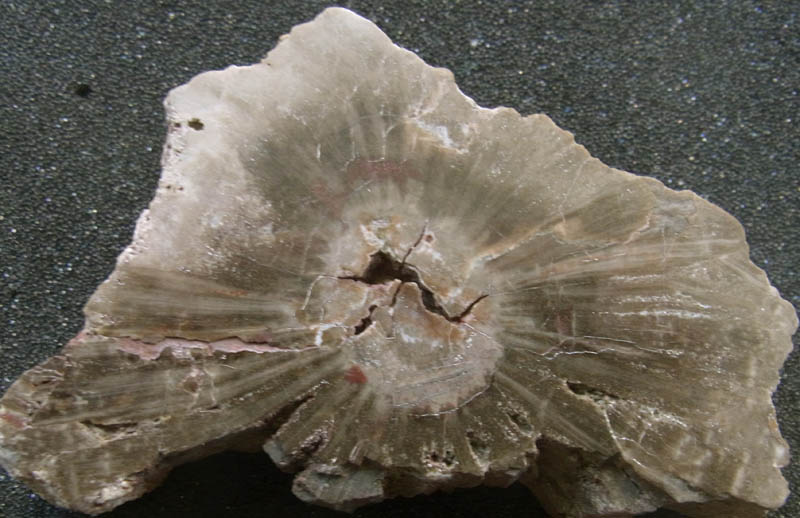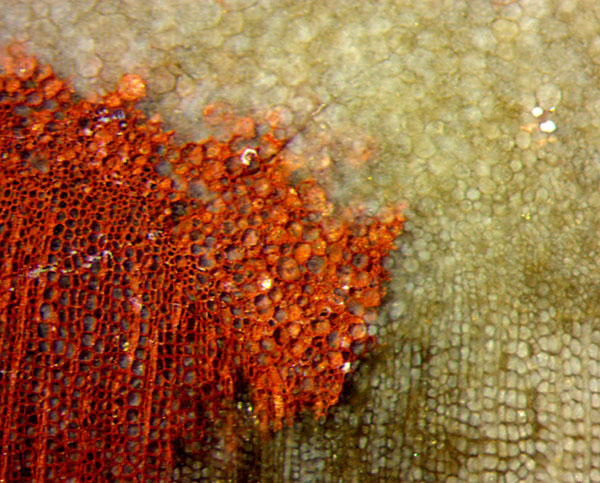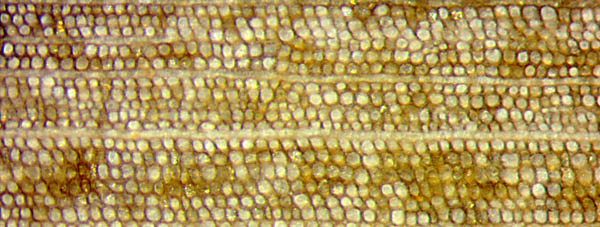Pith in petrified wood from
the Kyffhäuser mountains
The central pith in extant trees, with diameters of no more than a
few millimeters, seems to be relevant in early growth stages only. With
increasing diameter of the wooden stem, it becomes more and more
irrelevant. This tendency is also seen in paleozoic wood. Most often,
petrified wood of the coniferous type is found as fragments. In rare
cases a fragment includes the centre of the trunk with well preserved
pith. This differs clearly from the surrounding wood (xylem)
with
its orderly radial cell files but the transition area between pith and
wood is confusing. The wood bordering to the pith, with cells much
smaller cells than those of both pith and "normal" wood, are usually
called protoxylem, which does not explain anything.
The
fragment seen here mimicks the cross-section of a calamite stem with
broad radial streaks but it is coniferous-type wood with a conspicuous
central pith area. By lucky incidence it can serve as a suitable object
for demonstrating the contact region between pith and wood. A red spot
of about 2mm with heightened contrast due to thin layers of hematite
deposited on the cell walls provides an unexpectedly clear image of the
tissue (Fig.2).
Fig.1: Fragment of petrified conifer trunk with large pith and broad
radial streaks of unknown cause in the wood, with well preserved
cellular structure, locally with deposits of red hematite on the cell
walls, notably in a red spot at the boundary of the pith below left.
Width 9cm.
Fig.2: Boundary of the pith area in Fig.1 with small-cell (15-25µm)
protoxylem
(?) between large-cell pith (100µm) and wood (30-50µm), here
particularly clearly seen owing to hematite on the cell walls, nevertheless
difficult to understand. Width of the
picture 2mm.
Fig.3 below right: Typical coniferous wood from Fig.1, with radial cell
files and pith rays, cells 40-50µm. Width of
the picture 2mm.


When magnified slightly as in Fg.1, not only the alternating radial
streaks but also the apparent "wood wedges" pointing into the pith seem
to mimick calamite wood.
In the middle of Fig.2, the pith seems to
force its way between two wood wedges but does not continue as a wide
primary pith ray as it would do with calamites. It simply is replaced
with wood (near the lower boundary of Fig.2).
Well away from the confusing transition area between
pith and wood with its varying cell sizes, there is the plain
coniferous-type wood (Fig.3) with the well-known narrow secondary pith
rays.
A central pith was absent in the first land
plants, quite large in the calamites, and much smaller in the tree
trunks with coniferous-type wood. In
the present case the pith is as large as with the cordaites,
the close relatives of the conifers, but the wood is that of the
"common" paleozoic conifers, summarily called Dadoxylon.
This
uncommon sample contains the hematite not only as a red stain made of
thin translucent platelets but also in a massive form as kidney iron
ore, 5mm wide, on the back.
W.+ G. Etzrodt have found this sample in their gravel pit at Borxleben, recognized it as something special, and provided it for investigation. It is kept under the label KyB/120.
H.-J. Weiss 2017
[1] K. Mägdefrau:
Die Kieselhölzer im obersten Oberkarbon des Kyffhäuser-Gebirges. Ber.
Dt. Bot. Ges. 71(1958), 133-142.
|

|
 27 27 |

 27
27



 27
27